The White Tie dress code represents the highest level of formal civilian attire for men.
It demands a complete and specific outfit, with rules established since the English Regency.
This guide will explain precisely how to execute the White Tie dress code correctly, as invitations are rare and attention to detail is paramount.
You will learn the strict rules for each garment, ensuring you achieve the required refined elegance, as White Tie offers little room for deviation unlike the more flexible Black Tie code.
Understanding the Specifics of the White Tie Evening Tailcoat
The garment North Americans call a tailcoat is more accurately termed an evening tailcoat or dress coat.
This distinguishes it from the formal day tailcoat, known as a morning coat.
The evening tailcoat has a pseudo-double-breasted design with a sharply cut-away skirt and lapels faced with silk.
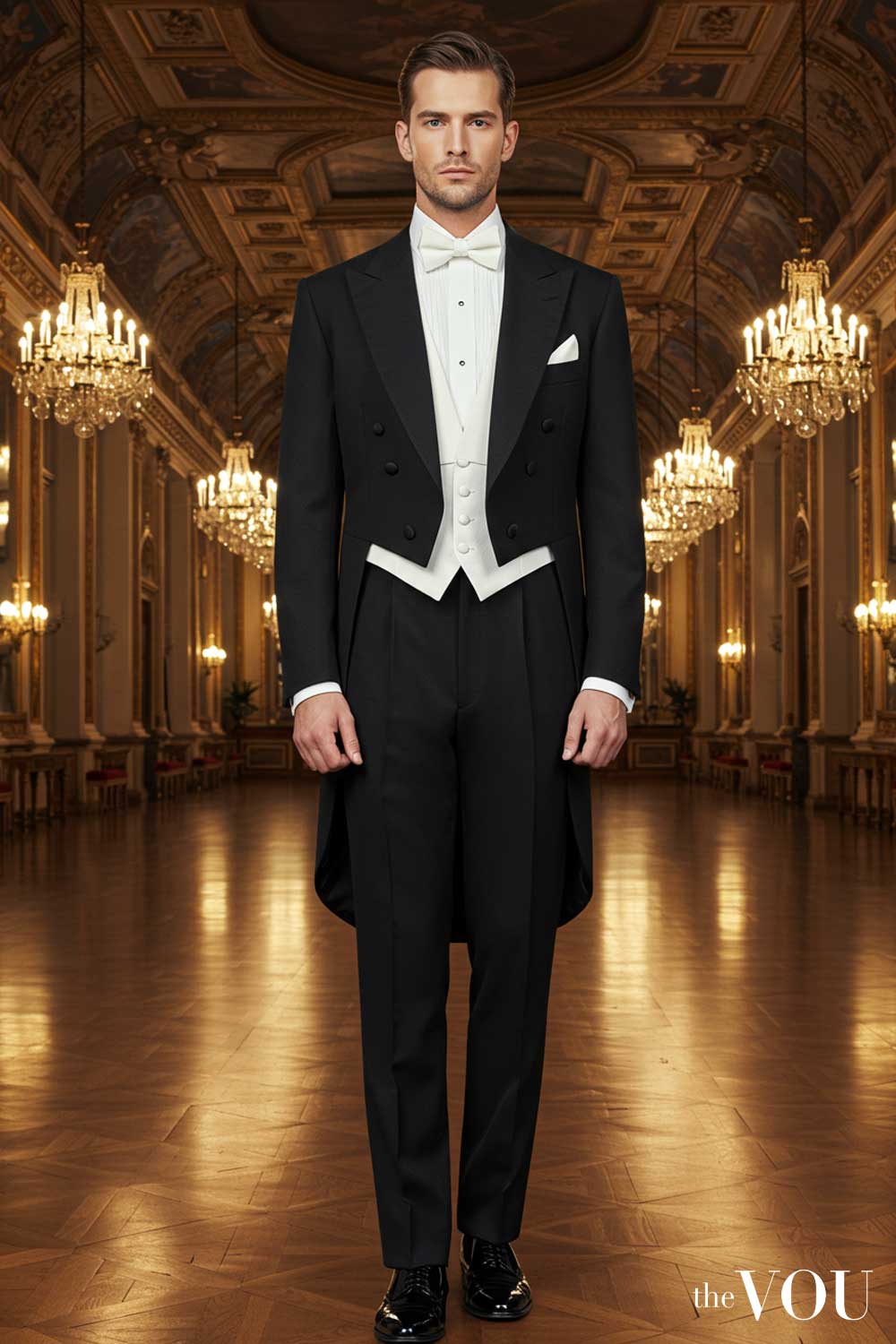
In contrast, the morning coat is single-breasted, features a skirt that tapers away gradually, and has self-faced lapels (lapels made from the same fabric as the coat body).
Your evening tailcoat must fit your torso snugly.
It is designed so it cannot be closed or buttoned in the front.
Achieving this snug fit means the coat must contour perfectly to your body.
If your proportions do not match a pre-made tailcoat precisely, you will need to invest in a custom-made dress suit for your physique.
A well-fitting tailcoat significantly benefits your appearance by accentuating positive features and minimising imperfections.
Barathea Worsted Wool in Black or Midnight Blue
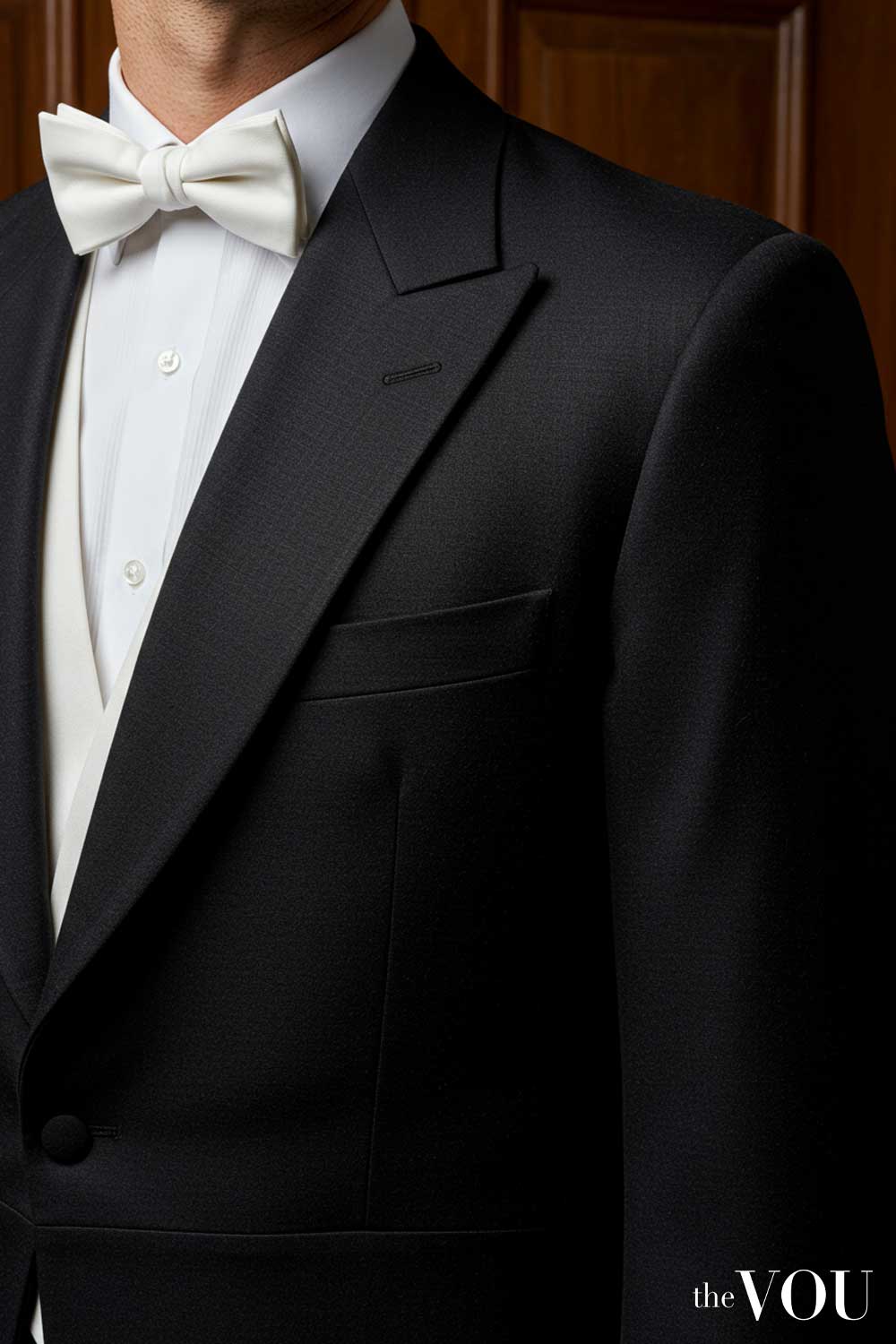
Worsted wool with an understated finish, such as barathea, has been the most common fabric for tailcoats since the late Victorian era.
This fabric is often preferred in Britain.
Mohair and wool blends have been acceptable alternatives since the late 1950s.
These blends are favoured for their ability to add a tasteful, dull sheen to the suit.
Black has been the standard colour for evening wear since the 1850s.
Midnight blue has been a correct and striking alternative to black since the 1920s.
Tailcoat’s Silhouette
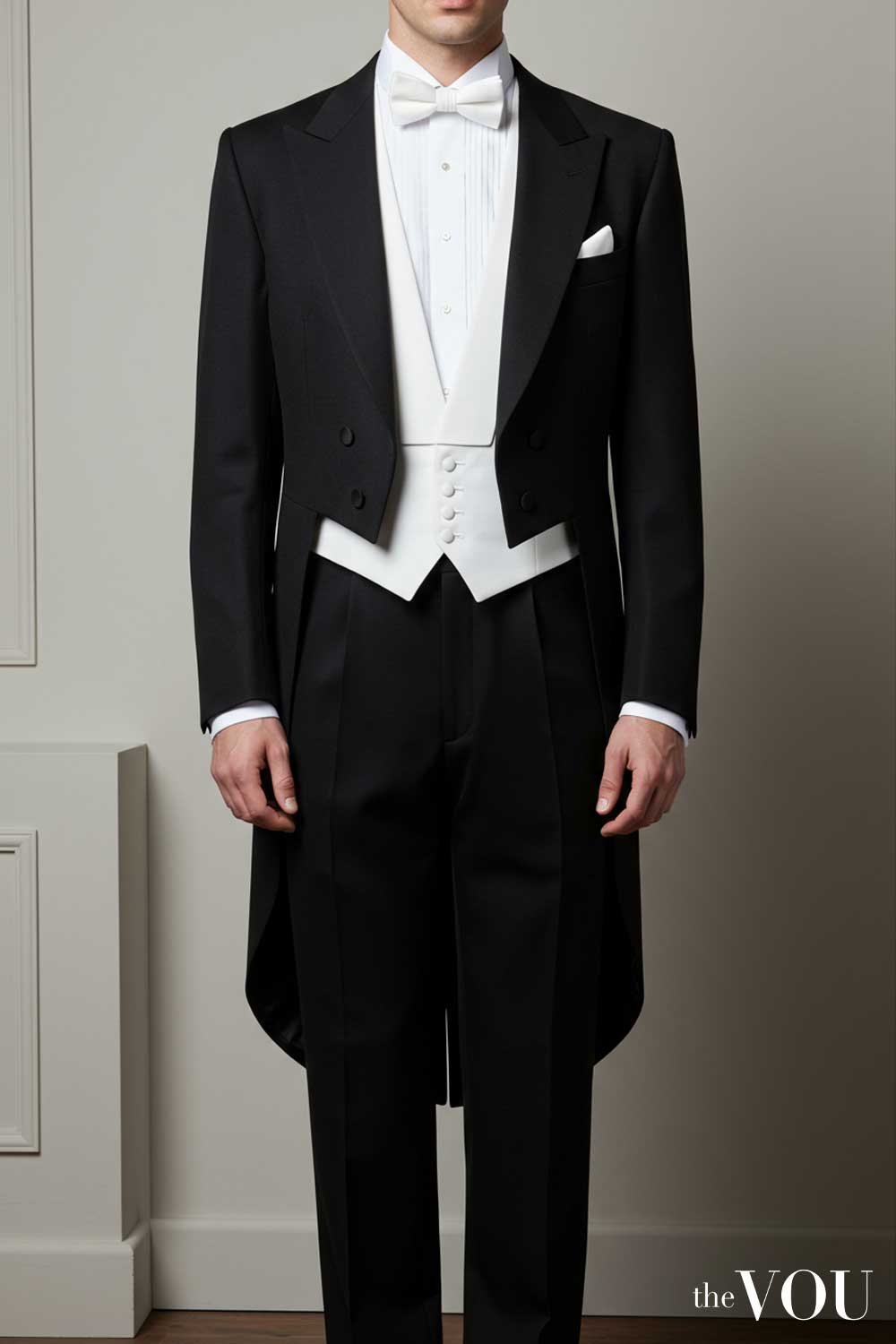
The design of the full-dress tailcoat is particularly effective at adding an illusion of height to men. This is due to its ability to visually elevate the waistline.
The tailcoat’s fronts, and the corresponding white waistcoat worn beneath it, end shortly below your natural waistline.
The dividing line between the white waistcoat and the black trousers visually bisects your body.
Deliberately raising this line gives the impression of longer legs.
Fred Astaire famously used an exaggerated waist height in his tailored full-dress suits for this effect.
The English also favoured this raised waistline in the 1930s for its dramatic aesthetic.
The front of the coat should be well opened, exposing a considerable area of your shirtfront.
The lapels should roll to a point slightly below the top button of your waistcoat.
From this point, the line of the coat front should slant away to the edge, which inclines slightly upward and rounds into the skirt.
The back and tails of the coat must be smooth, without any creases.
The coat’s collar must fit snugly at your neck.
It should rise just high enough to cover the shirt collar’s rear stud and the bow tie’s band, while still allowing a significant portion of the white shirt collar to remain visible.
Decorative Tailcoat Buttons
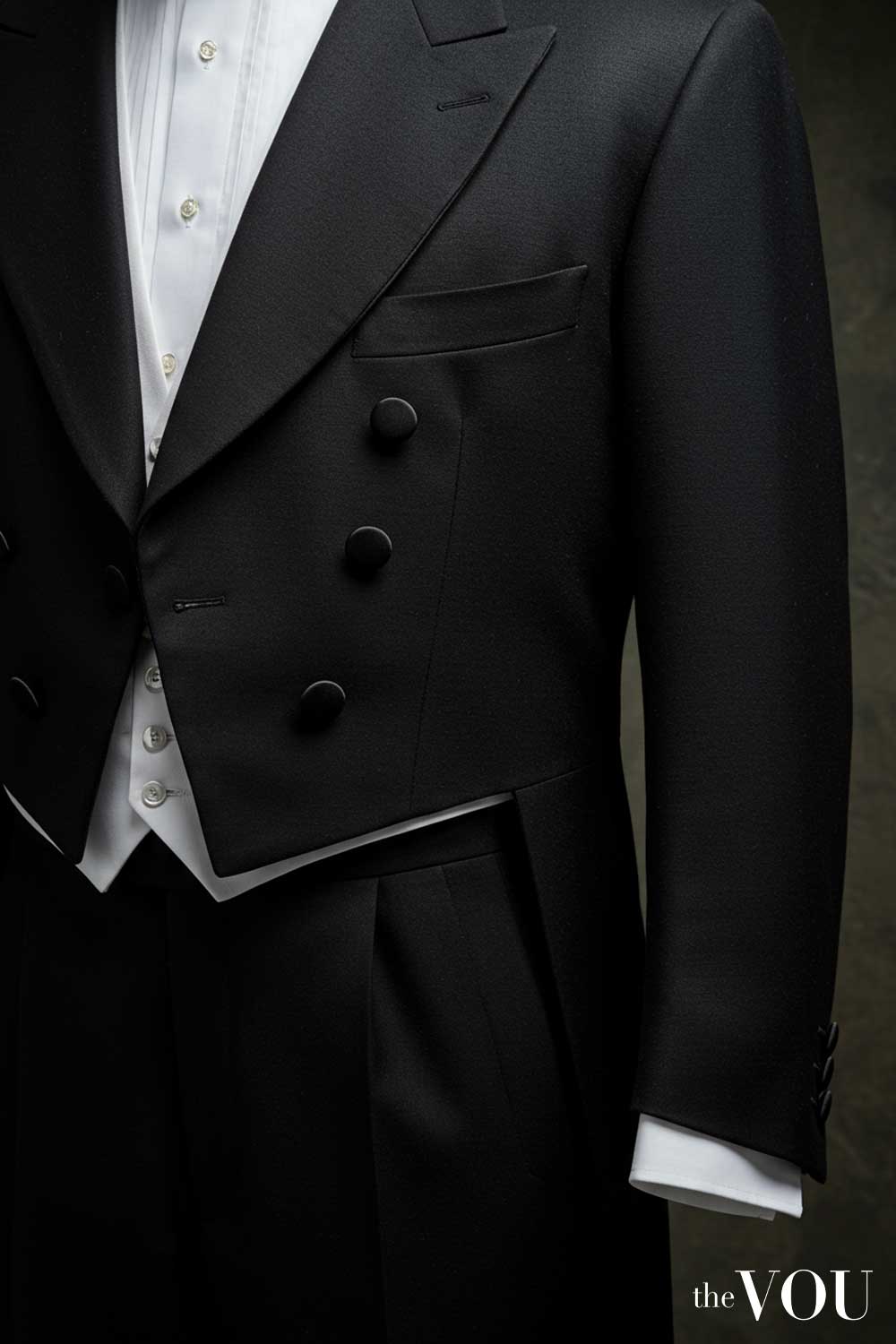
The double-breasted evening tailcoat has not been designed to close at the front since the 1820s.
Therefore, the two rows of front buttons are purely decorative.
There are typically three buttons in each diagonal row, and their spacing is a matter of style.
Sleeve buttons are also ornamental.
You should have four buttons spaced closely together, beginning about half an inch from the end of the sleeve.
In the 1920s and 1930s, tailcoats sometimes featured only one, two, or three sleeve cuff buttons.
Peaked Lapels Faced with Silk
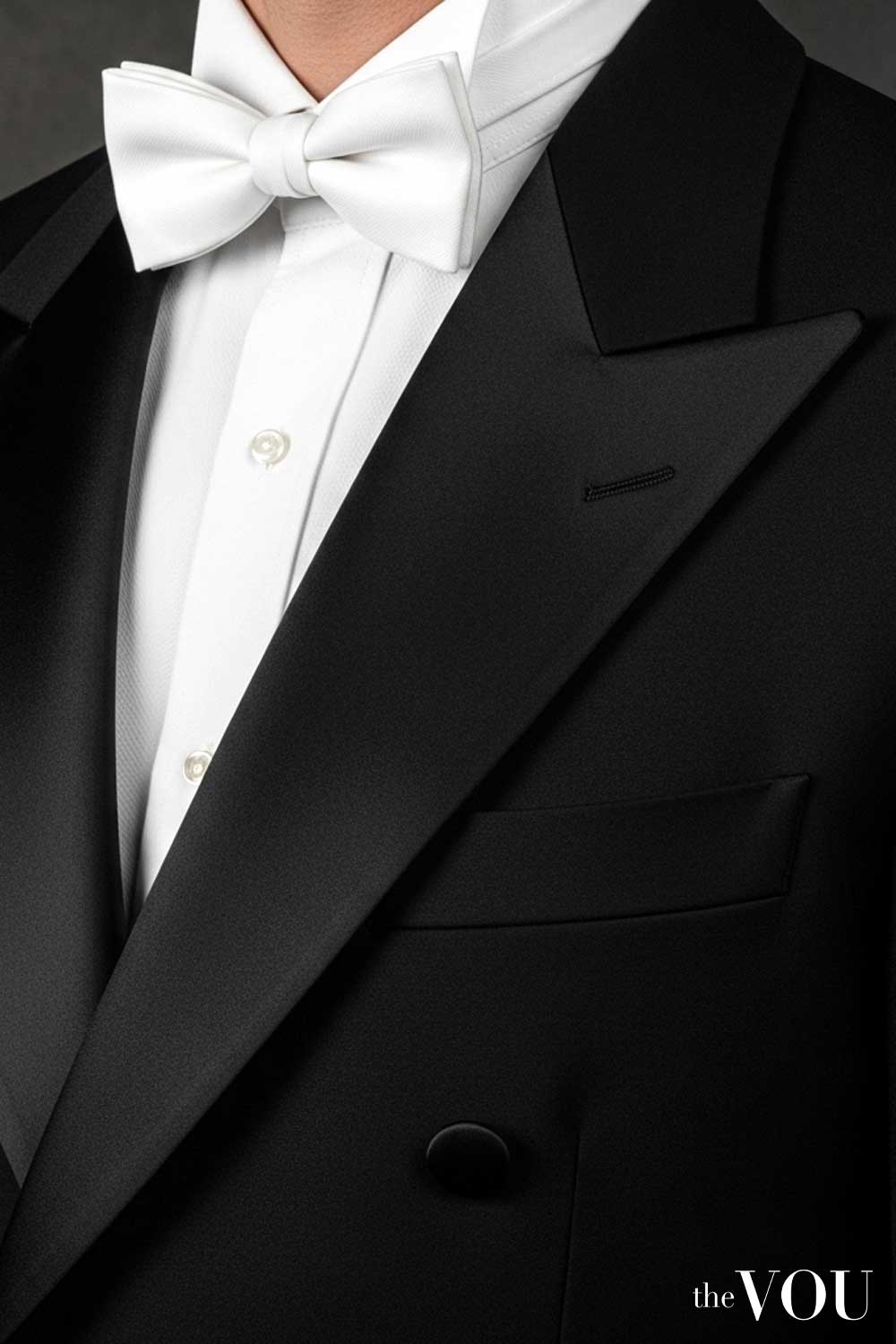
The peaked lapel has been the standard for evening tailcoats since the turn of the twentieth century.
It is the most formal style of suit lapel.
Its sweeping upward diagonal lines also create the impression of a powerful V-shaped torso.
You might occasionally find vintage tailcoats from the interwar period with a shawl collar.
This style was an alternative when full dress was worn frequently, and gentlemen sought variety.
Unless you attend white-tie events regularly, it is best to leave the shawl collar to sartorial history.
Some modern designers have paired the formal tailcoat with the informal notch lapel typically found on business suits.
Choosing this style often indicates that the garment is rented rather than owned and carefully selected.
Ensure Lapel Facings are Silk in Satin or Grosgrain
The best lapel facings are made of pure silk.
Less expensive options might contain a synthetic component.
The silk can have a smooth satin finish or the dulled, ribbed texture of grosgrain.
Satin is more common in North America, but its shiny finish is not as popular in Britain.
In Britain, the understated look of grosgrain is often preferred.
Your left lapel must have a working buttonhole for a boutonnière.
Quality formal coats will also include a small stem holder on the reverse side of the lapel to keep the flower in place.
Tailcoat Sleeves are Cut for Movement and Show Shirt Cuff
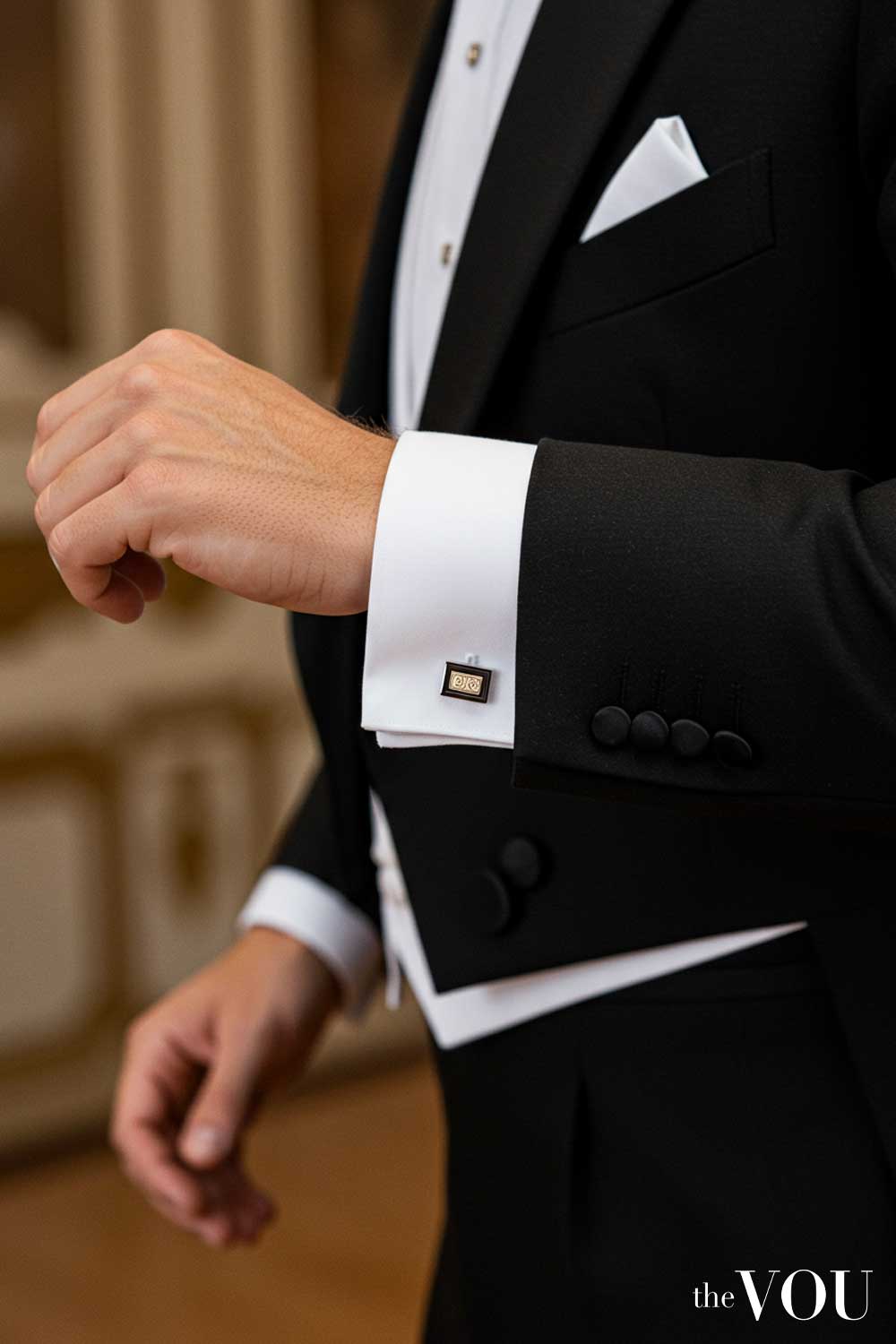
Tailcoat sleeves should incorporate high armholes.
This construction prevents the coat’s sleeves from pulling at the body, regardless of your arm movements, which is important for activities like dancing.
Similar to the coat collar, the sleeves should be cut short enough to reveal about half an inch to one inch of the white shirt cuff, depending on your height.
Tailcoat sleeves are also relatively narrow, traditionally just wide enough to allow the shirt cuff to slip through smoothly.
Tails Extend to the Bend of Your Knee
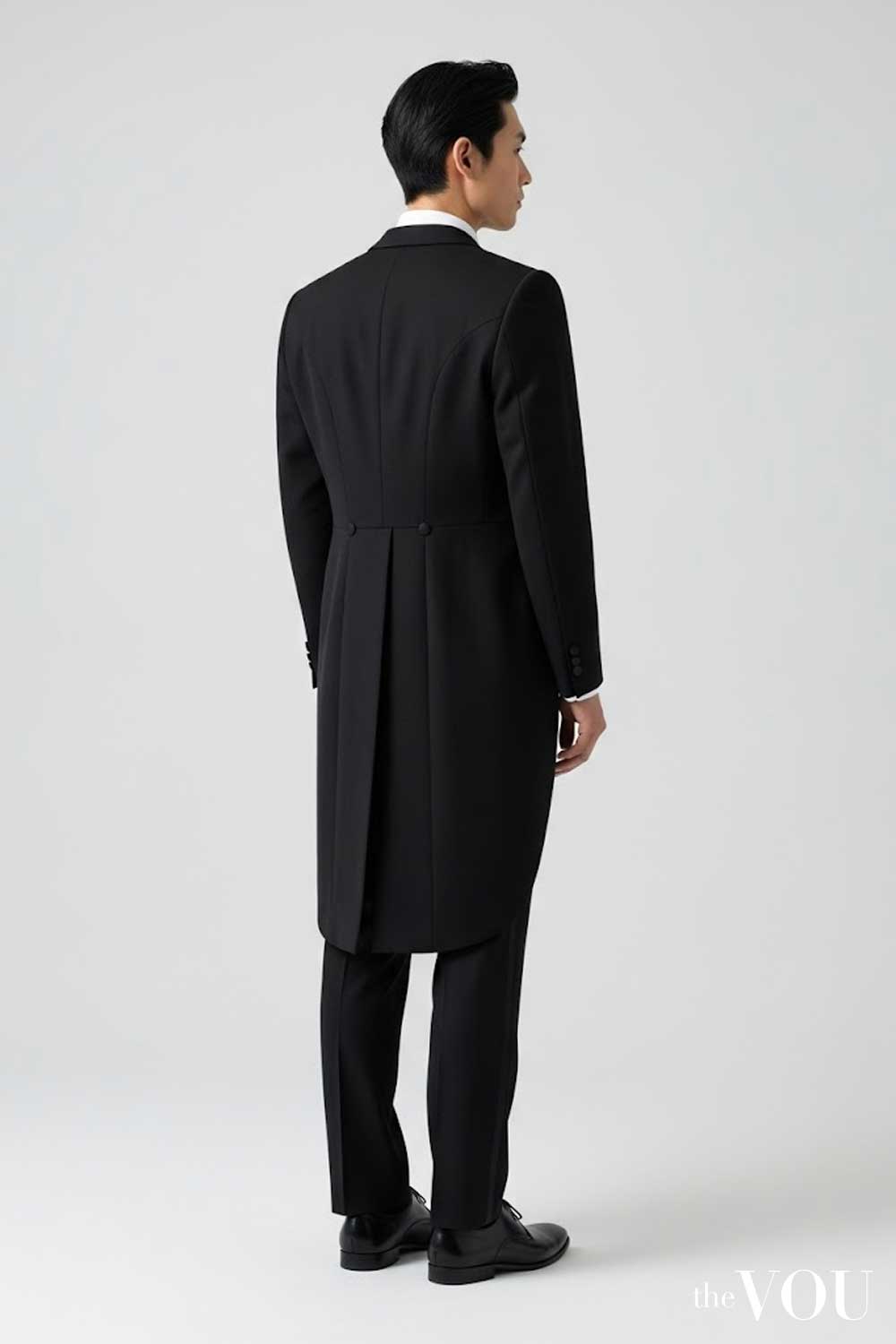
A centre vent rising to the waistline divides the coat’s skirt into two “tails”.
These tails generally extend down to the bend of your knee.
They should hang in a straight line with a gentle curve at the bottom.
Tailcoats Traditionally Have No External Pockets
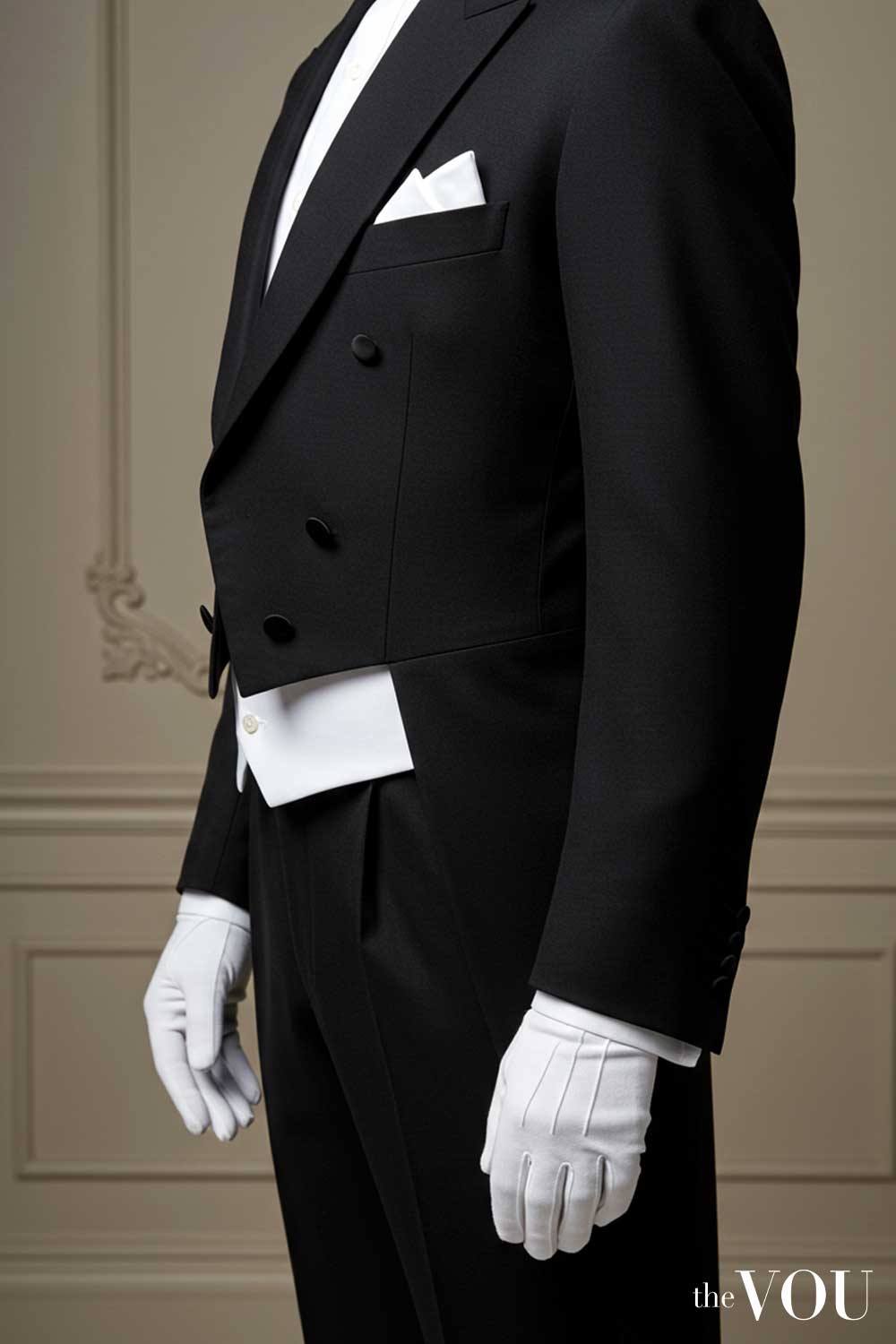
An 1837 etiquette manual advised that coat pockets should carry as little as possible, and a full-dress coat should be made without them.
The weight and bulge of loaded pockets obstruct the graceful lines of the contoured dress suit.
Consequently, hip pockets are never seen on a tailcoat.
A breast pocket, introduced in the Edwardian era, is typically left empty by meticulous dressers.
To address the need for carrying small items like dress gloves when dining, pockets were historically hidden in the inside folds of the coat’s tails; this remains a feature of better tailcoats today.
Other Tailcoat Construction Details
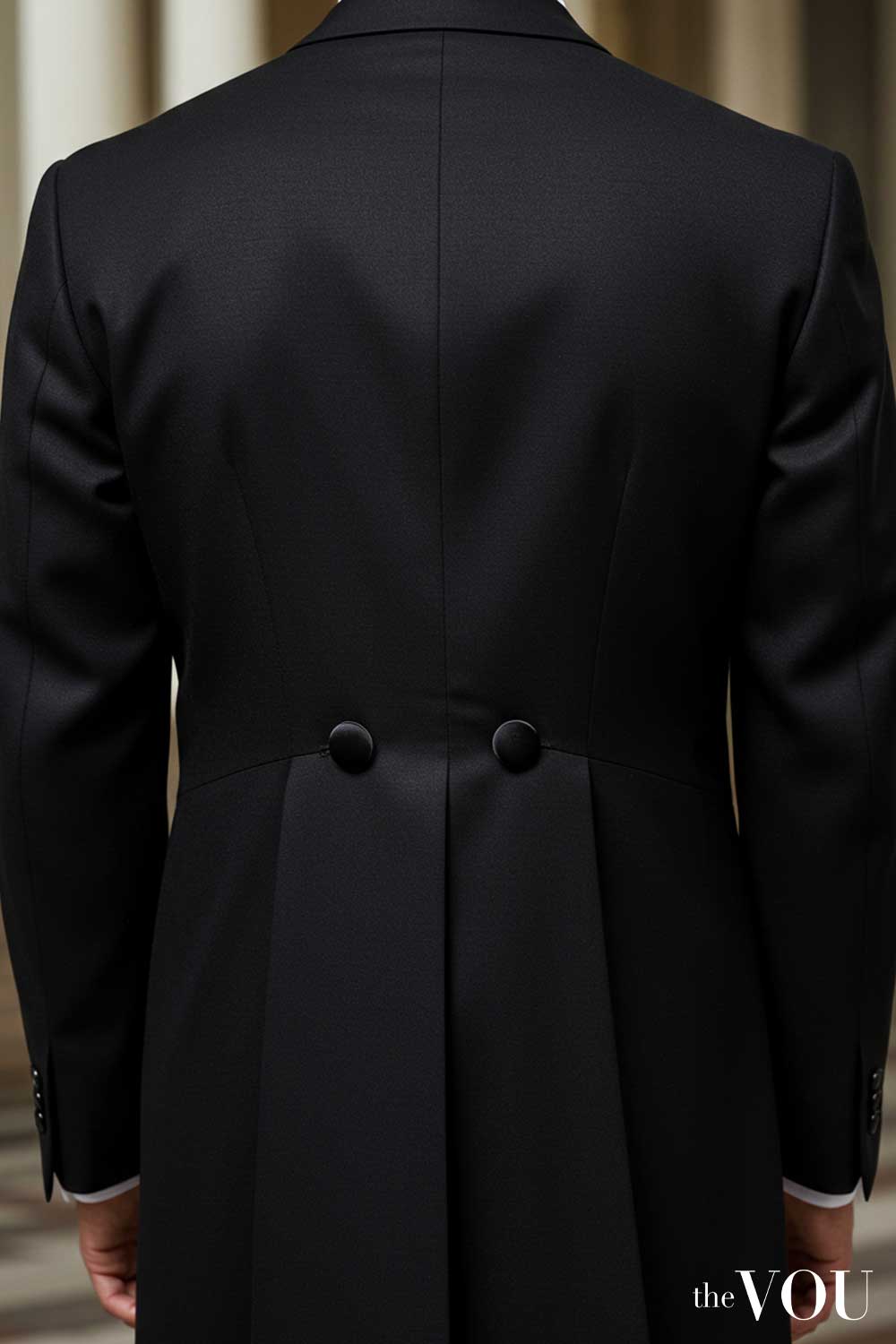
Most other aspects of a tailcoat’s cut, such as the amount of fullness over the chest and back (drape), shoulder padding, and the curve of the lapels, are aesthetic and subject to changing fashions.
Unique to the tailcoat and morning coat are two buttons found at the back of the waistline.
These are a historical remnant from when the coat’s tails were folded and buttoned to the back for convenience during activities like horse riding.
All buttons on the tailcoat can be covered in the same silk facing as the lapels or in cloth, but simple black or textured buttons are also acceptable.
High-Waisted Full-Dress Trousers in Matching Fabric
Full-dress trousers must be constructed from the same fabric as your tailcoat.
They must have a high rise (waistline) so they sit just above the bottom of the tailcoat’s fronts.
It is essential that they remain in this position throughout an evening, so they must be cut for and held up with suspenders (braces in the UK).
Trousers can be flat-fronted, as they were before the 1920s, or pleated, which became popular with baggier fashions after the First World War.
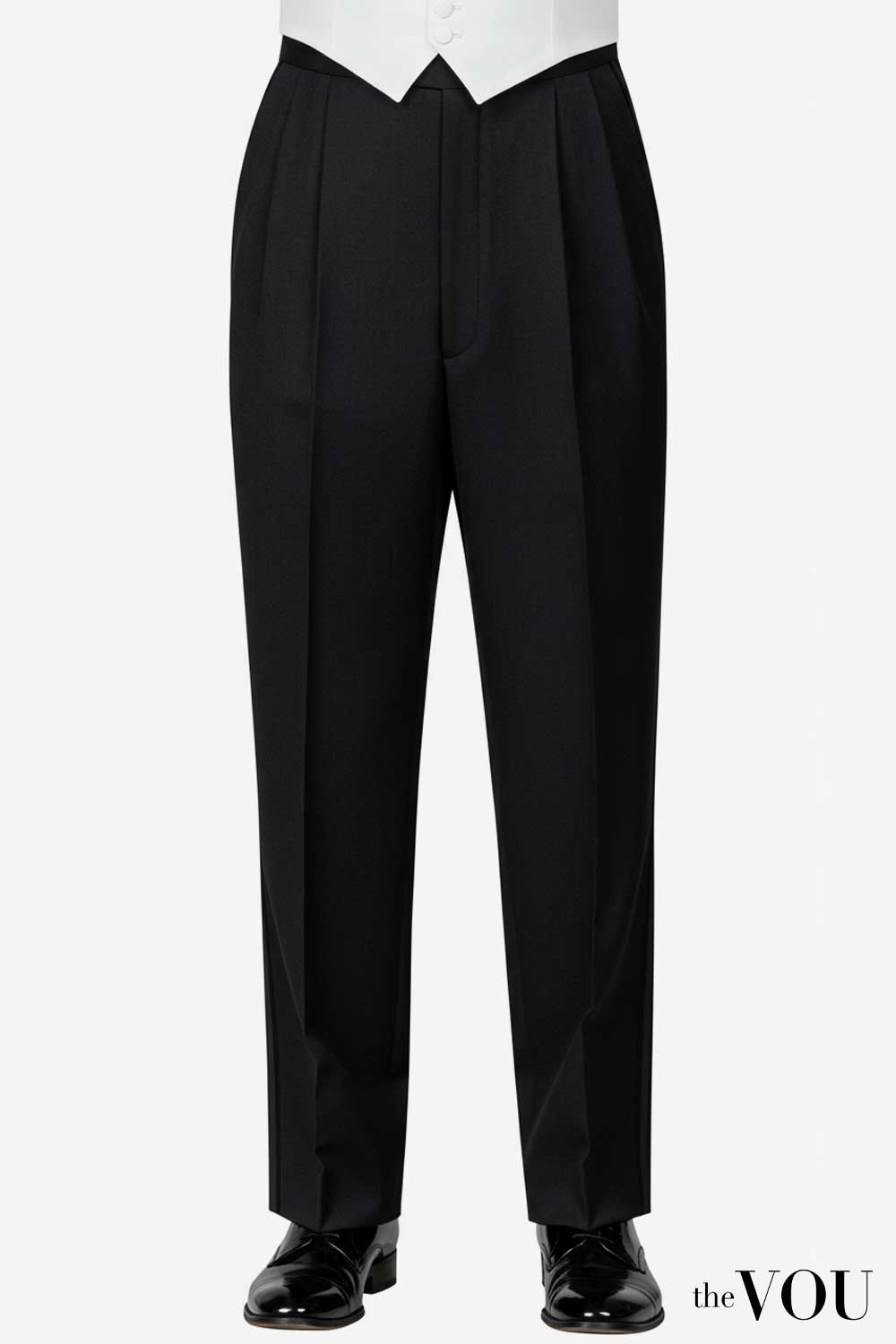
A key characteristic of formal clothing is the concealment of its workings.
This is seen in the silk-covered coat buttons and the decorative studs on a formal shirt.
It also applies to the trim that covers the outer seams of formal trousers.
This silk trim, known as gallon, is either satin or grosgrain to match the coat’s lapels.
For white tie trousers, it traditionally consists of two narrow stripes or one wide stripe to differentiate them from tuxedo trousers (which typically have a single, narrower stripe).
Braid was also historically used for this purpose.
The refined minimalism of the evening suit is further aided by placing the side pockets on the trouser’s side seam, making them virtually invisible.
Formal trouser legs must always be plain at the bottom; cuffs (turn-ups in the UK) are too casual as they originated as mudguards and would interfere with the side braid.
When you sit while wearing a tailed coat, do not divide the tails; carefully place them over the side or back of the chair.
Arm Scye and Trouser Stripe Details
A coat’s arm scye is the hole where the sleeve attaches to the body.
High arm scyes allow the sleeves to move more independently of the coat body, which is why this is a standard feature of custom-made tailcoats for orchestra conductors.
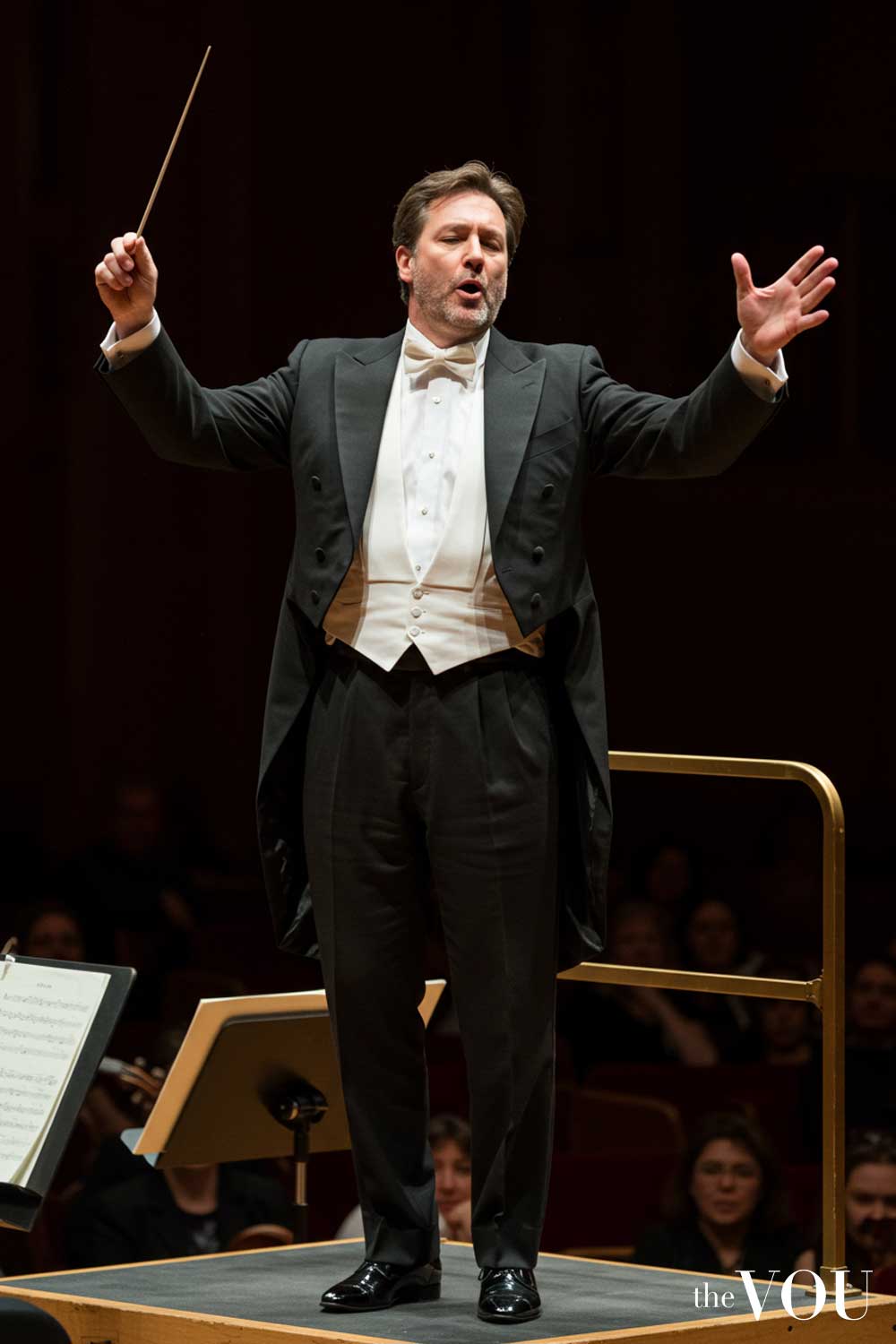
Avoid tailcoats marketed with black-tie accessories or those featuring informal notched lapels, often with unnecessary fancy trim, as these are signs of lower quality or costume wear.
If you opt for a custom tailcoat, you might consider ordering a dinner jacket (tuxedo jacket) simultaneously and sharing one pair of formal trousers between them, provided the trouser stripe is suitable for both (a single stripe is more versatile if doing this).
Single-striped formal trousers are an acceptable alternative for white tie, though double-gallon stripes are the most traditional for a full-dress ensemble.
Stiff-Fronted White Marcella Piqué Bib Shirt with a Detachable Wing Collar
The full-dress shirt is a crucial element of the white tie ensemble. Its specific details contribute significantly to the outfit’s regal bearing.
The body of the shirt is typically made of broadcloth or a lightweight fabric such as voile to help keep you cool.
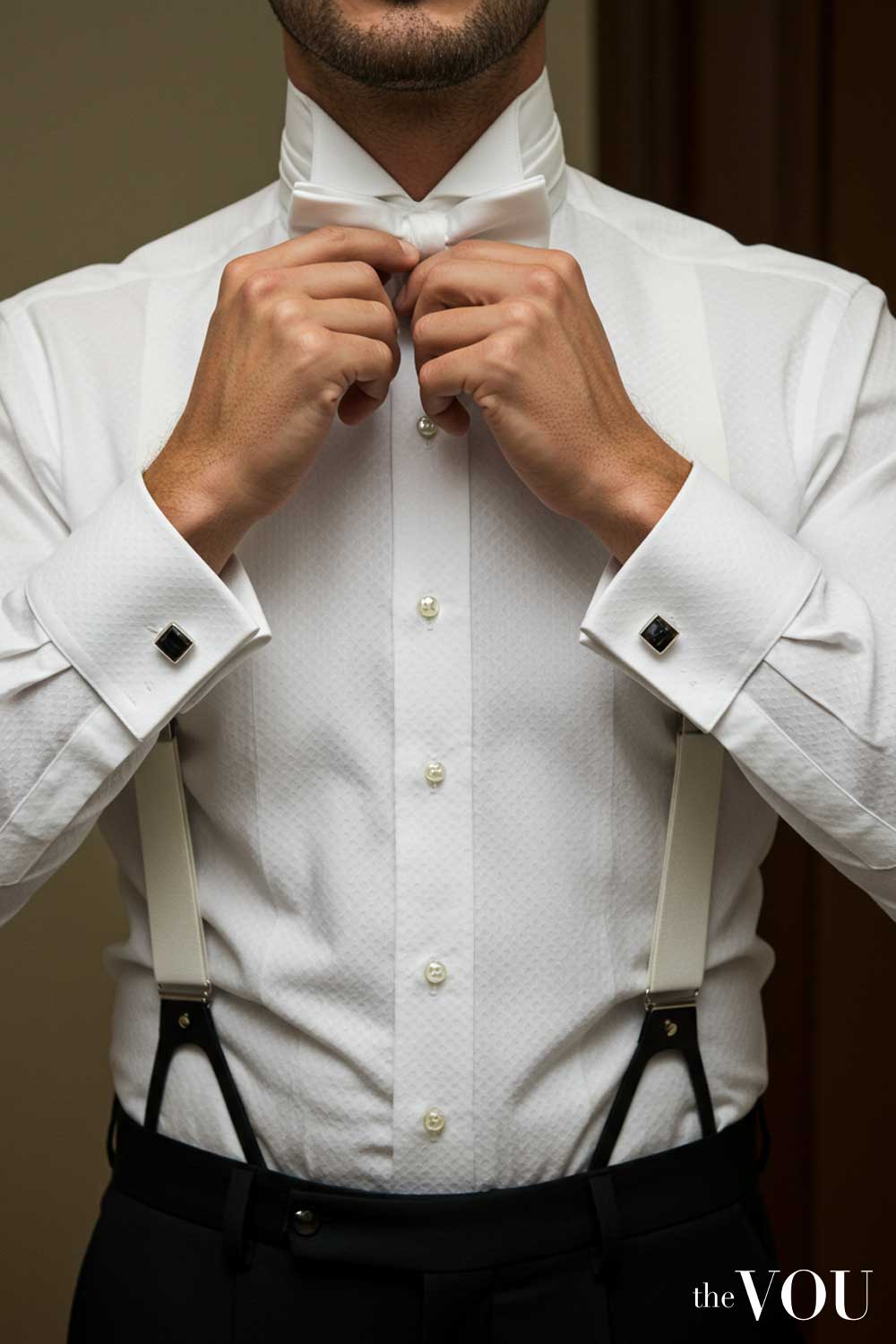
It is constructed in a collarless “tunic” style to accommodate the essential detachable collar.
Only the collar, the shirt front (bosom), and the sleeve cuffs are visible when the outfit is complete.
Stiff and Plain Shirt Front Bosom (Bib)
The classic full-dress shirt features a stiff and simple bosom made from plain linen, plain cotton, or cotton piqué (marcella in the UK).
This thick, bib-shaped layer of fabric is heavily starched.
This gives the appearance of a firm, flat torso, regardless of your actual physique.
To prevent the stiff shirtfront from billowing when you sit down, a properly tailored bosom will end just above your trouser waist and sit inside your suspenders.
The front traditionally has one or two visible studs, depending on your height (a single stud can create an illusion of increased stature) or personal taste.
Modern shirt studs are designed to fasten securely, as vintage studs can be too small for contemporary starched buttonholes and may pop open.
Different Piqué Weaves for Shirt Fronts
Birdseye piqué, also known as marcella, is the most popular style for formal shirt fronts.
The finer the weave of the piqué, the more elegant the shirt front will appear.
Various piqué weaves exist, including waffle (small squares), honeycomb, and birdseye (small diamonds).
Traditional “Boiled Shirt”
The classic full-dress shirt is sometimes referred to as a “boiled shirt” due to the heavy starching process that gives it its stiffness.
Historically, these shirts sometimes featured back-closing designs, detachable cuffs, or even a detachable bosom (often called a dickey), though these are rare today.
How To Insert Shirt Studs Correctly
Inserting shirt studs can be challenging because the starched marcella piqué is very stiff.
Some white tie shirts feature a side opening on the left, allowing you to reach the studs from behind, which is helpful.
If your shirt lacks this opening, button everything from the top down, which allows you to see the back of the studs from the bottom of the shirt opening as you work.
Tall, Stiff, Detachable Wing Collar
The collar of the full-dress shirt is distinguished by its folded wings and its height.
Originally, these detachable collars stood nearly as high as the wearer’s jawline.
Even today, a proper white tie collar should extend at least three-quarters of an inch above the coat collar.
The combination of heavily starched fabric and broad wings helps keep the bow tie perfectly in place and frames the face effectively.
Detachable collars are fastened to the tunic shirt with a shorter stud at the back and a longer one in front to accommodate the fabric’s overlap at the throat.
Only the front stud touches the neck, so its flat back should be of bone or mother-of-pearl to avoid marking the skin; metal is not ideal here.
It is much easier to attach the back of the collar to the shirt before putting the shirt on.
Single Cuffs Fastened with Links
The most formal style of shirt for white tie uses stiff single cuffs (also known as barrel cuffs, though this term can be confusing as it’s also used for buttoned cuffs on less formal shirts).
These are intended to extend further beyond the coat sleeve than the softer French-style double cuffs typically worn with a dinner jacket (black tie).
Although not folded back like French cuffs, these single cuffs are always fastened with cufflinks, not buttons.
They can be made of plain linen, cotton, or piqué to match the shirt’s bosom.
Shirt Loops and Tabs for a Neat Appearance
A little-known detail today is that when a bow tie is worn with a wing collar shirt, its band should never be visible above the coat’s collar at the back of the neck.
A finely tailored formal shirt will have a small loop stitched immediately below the collar at the back.
This loop is for discreetly tucking away the bow tie’s band and the backless waistcoat’s neck strap, keeping them hidden under the jacket.
Quality formal shirts also feature a tab at the bottom that attaches to the inside of the trouser waistband to prevent the shirt from riding up.
This tab is hidden by the waistcoat.
Formal shirts do not have pockets, as they would interfere with the reinforced bosom and are not considered dressy.
Attached Wing-Collar Shirt as an Acceptable Modern Alternative
The use of traditional detachable wing-collared shirts declined after the 1930s as dinner jackets (black tie) became more common than tailcoats for evening wear.
As detachable collars became less popular, fewer dry-cleaners could properly launder and starch them.
In response, manufacturers began producing full-dress shirts with attached wing collars in the 1960s, and this style became the norm by the 1970s and 1980s.
If you cannot find a traditional detachable collar shirt, look for a contemporary attached-collar version that resembles the classic archetype as much as possible.
This means the collar should be taller than typical shirt collars (at least one and a half inches), feature pronounced wings rather than small tabs, and have a fused construction to remain as stiff as possible during wear.
All other details, such as the stiff, minimally decorated bosom, remain the same as the classic shirt; soft-pleated fronts are strictly for black tie.
White Piqué Backless Waistcoat
The full-dress waistcoat (vest) must be constructed of white piqué (marcella in the UK).
It can be single-breasted or double-breasted.
It always features a deep V-shaped or U-shaped opening and is typically made in the backless style, which was popularised in the 1920s.
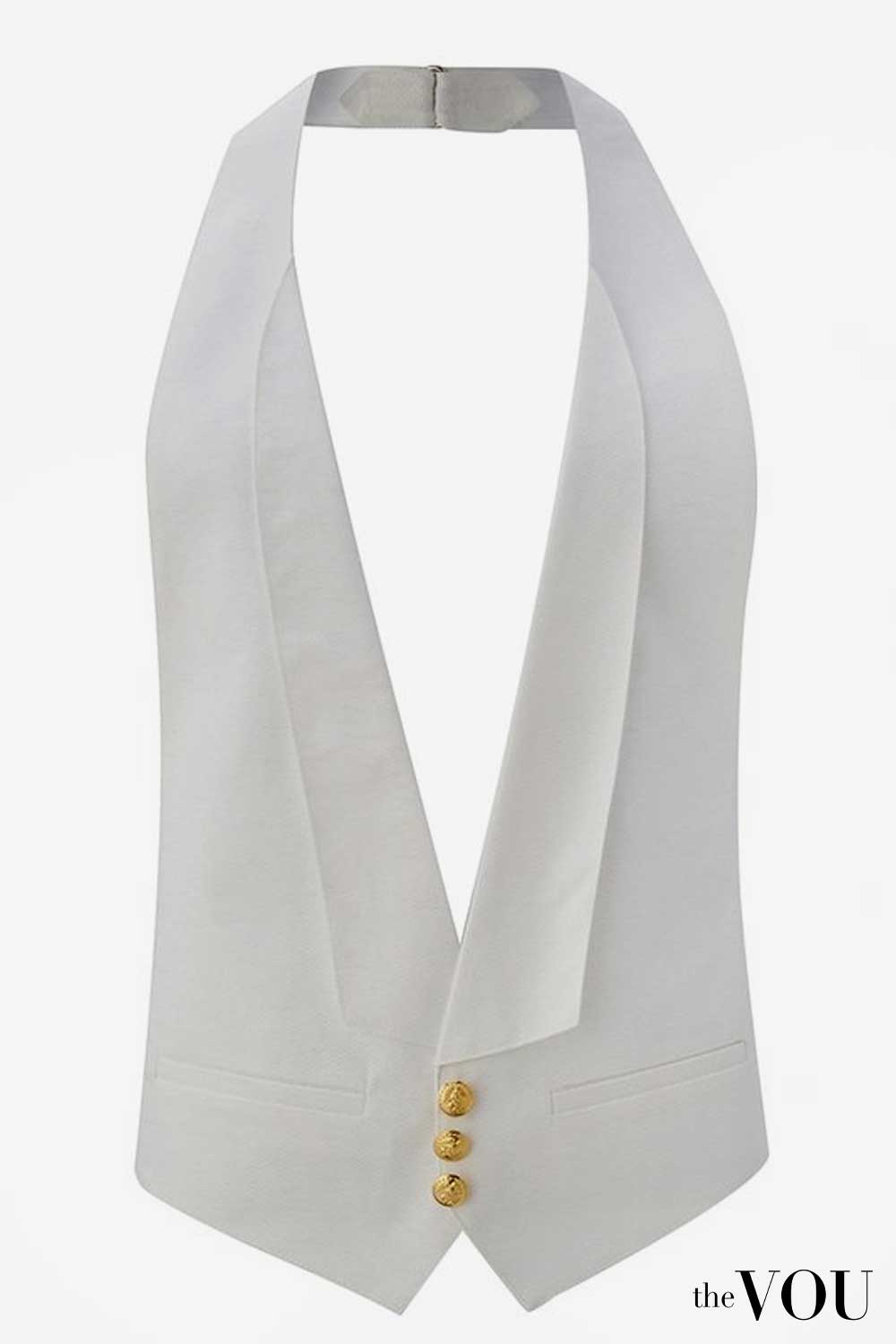
The most critical aspect of the waistcoat is its length.
Novices might treat it like a typical suit vest, assuming its length is irrelevant as long as it covers the trouser waistband.
This is incorrect for white tie.
With a tailcoat cut high at the waist level, a long waistcoat’s bottom will be completely exposed beneath the coat fronts.
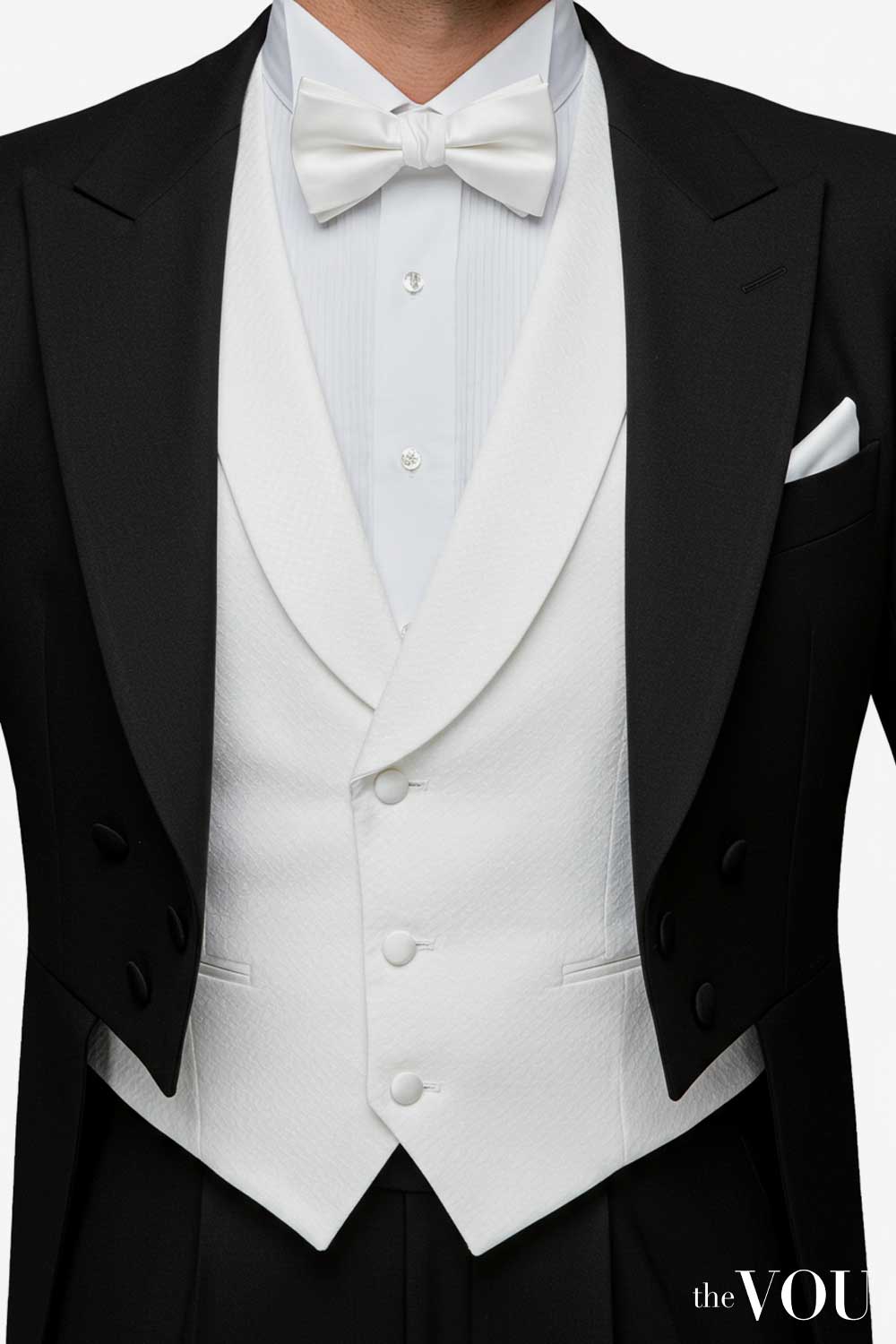
This creates a discordant look, especially with the stark contrast between the black coat and white vest.
Therefore, your full-dress waistcoat must be altered or custom-tailored to suit your tailcoat.
It must be long enough to cover your trouser waistband yet not so long that it extends below the fronts of your tailcoat.
Within these parameters, the shape of the waistcoat’s lapels (revers) and its bottom edge can vary, making it one of the few garments in the white-tie uniform where a personal touch can be added.
White Cambric as a Historic Waistcoat Fabric Alternative
For a short period during the 1930s, a smooth cotton cloth with a high shine called white cambric was also used for white tie waistcoats, shirts, and bow ties, but this trend did not become mainstream.
Fine Finishes on Waistcoat
Better quality waistcoats will have a neckstrap that adjusts with buttons rather than a metal ring.
Neither type of fastener should be visible, as a proper full-dress shirt will have a loop at its upper back to keep the neckstrap (and the bow tie band) from riding up above the tailcoat’s collar.
Finer waistcoats also feature a small loop near their bottom edges that fastens to the inside of your trousers, ensuring the waistcoat does not ride up and expose the waistband.
A single-breasted model typically closes with three buttons, while a double-breasted version usually takes four.
The buttons are usually self-faced (covered in the same piqué fabric) or mother-of-pearl.
On better models, these buttons can be replaced with formal waistcoat studs if desired.
Formal Styling Tips for Waistcoat
If your white tie shirt has a loop for the waistcoat neckband, you must fasten the band after putting it through the loop.
This is nearly impossible once the shirt is on your back, so you must do this step before putting on the shirt.
Black waistcoats are generally worn by service staff at white tie events or were historically worn at formal funerals; today, white waistcoats are the standard for guests.
White Marcella Piqué Self-Tie Bow Tie
The white full-dress bow tie is almost always made from cotton piqué (marcella in the UK), which has been the material of choice since the 1930s.
It is considered particularly smart if the tie is of the same type of piqué as your waistcoat and, if applicable, your shirtfront, though achieving this exact match can be difficult unless all items are from the same brand.
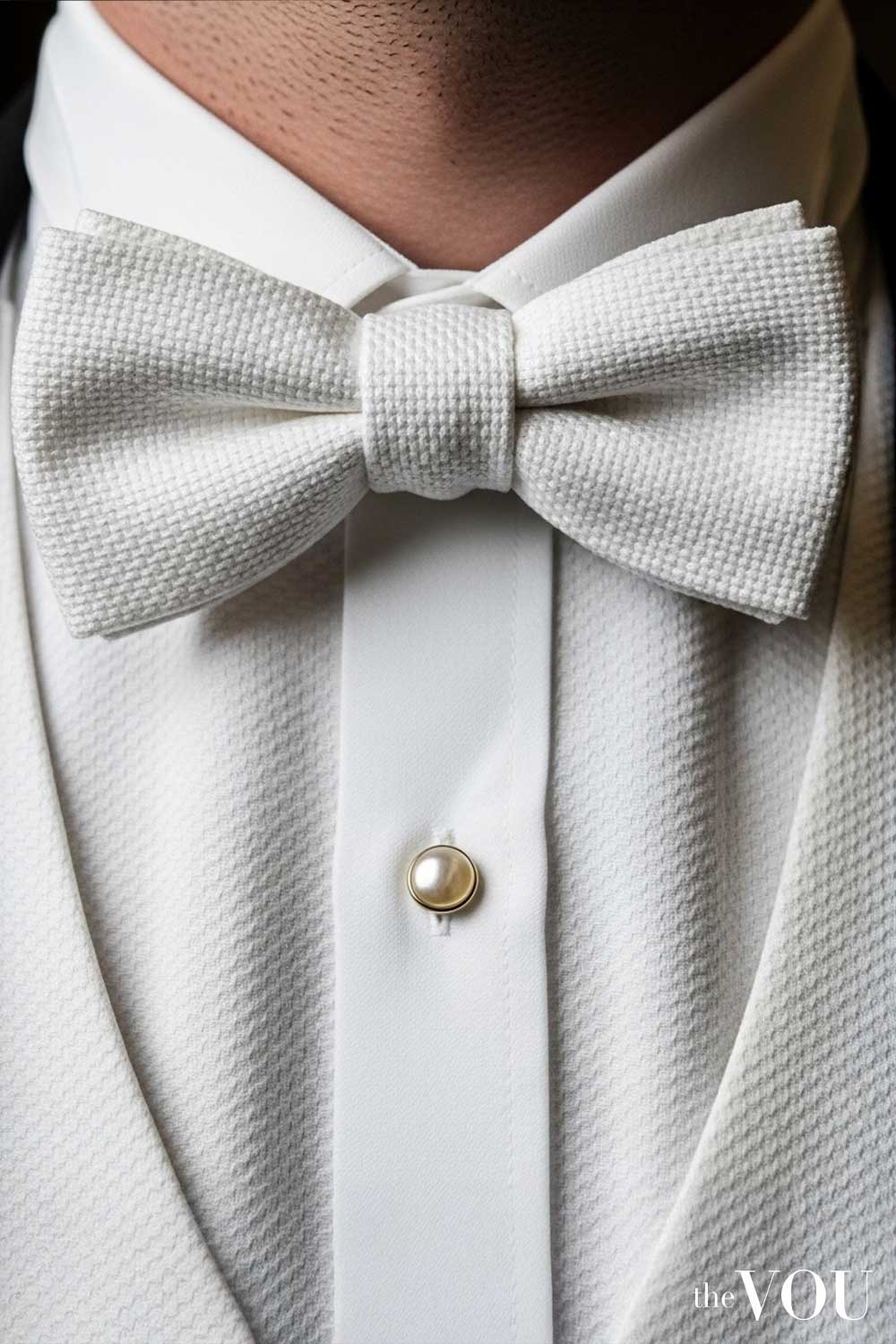
Select a Classic Bow Tie Shape Like Semi-Butterfly or Batwing
The bow tie is traditionally semi-butterfly or batwing-shaped.
Historically, many different white tie bow shapes were available, including those with pointed ends.
However, as white tie occasions are increasingly rare, most gentlemen stick to the classic semi-butterfly shape.
Insist on a Self-Tie Bow Tie; Avoid Pre-Tied Versions
A self-tied bow tie is vastly preferable to a factory-assembled pre-tied version.
If pre-tied neckwear is considered unrefined for everyday office environments, it is unequivocally inappropriate for an ultra-formal event such as a state dinner or Nobel Prize ceremony.
White tie is a gentleman’s uniform, and a gentleman appreciates the human touch of a slightly irregular hand-tied knot over the cold perfection of a pre-fabricated item.
Many marcella bow ties today have a size adjuster to reduce stocking costs for retailers.
However, unlike black tie shirts which often have a turndown collar, a white tie shirt always has a wing collar.
This means an adjuster on the bow tie band will be visible on the collar, which looks untidy.
Worse, the hook mechanism might come undone.
Therefore, you should opt for a sized white marcella bow tie (one made specifically for your neck size) or a single-end bow tie to avoid any visible adjusters.
Remember that formal bow ties are meant to be worn outside the collar’s wings, not tucked behind them when tying the tie.
Finally, unless you are a waiter or butler, you must never wear a black bow tie with a tailcoat.
Consider a Single-End Bow Tie for Ultimate Elegance
The standard bow tie is the regular style in a fixed neck size.
In the 1930s, dapper gentlemen introduced the single-end bow tie to create an even more elegant look.
Its advantage is that it has no adjusters, yet it can be made as a one-size-fits-all design if cleverly constructed, or it can be sized.
A smaller single-end white tie is perfect for men of more modest build or for vintage enthusiasts who want a period-appropriate small bow tie for their full-dress ensemble.
Black Patent Leather Oxfords or Formal Pumps with Silk Hose
Formal lace-up shoes, specifically capless or whole-cut patent leather Oxfords, or mirror-shine polished calfskin Oxfords, are the correct dress shoes for a full-dress white tie ensemble.
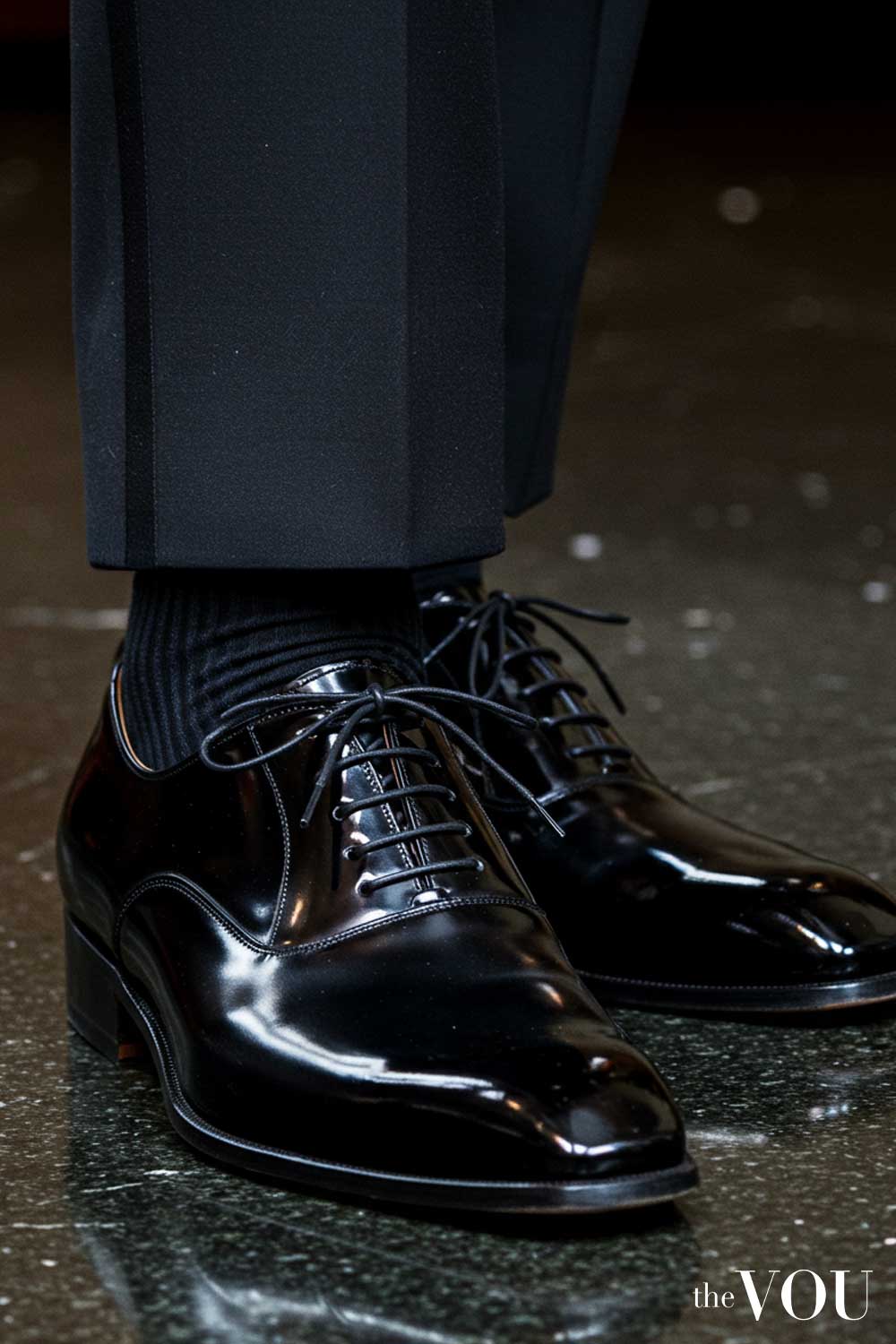
Patent leather is generally preferred for full dress because it reflects light better than even highly polished calfskin.
If you do wear calfskin, ensure they are polished to a mirror shine and consider using evening shoelaces that match your lapel facings in formality.
However, the formal pump is considered by some to be the most historically appropriate and formal of evening shoes, best suited to the evening tailcoat, given its origins in 16th-century court dress.
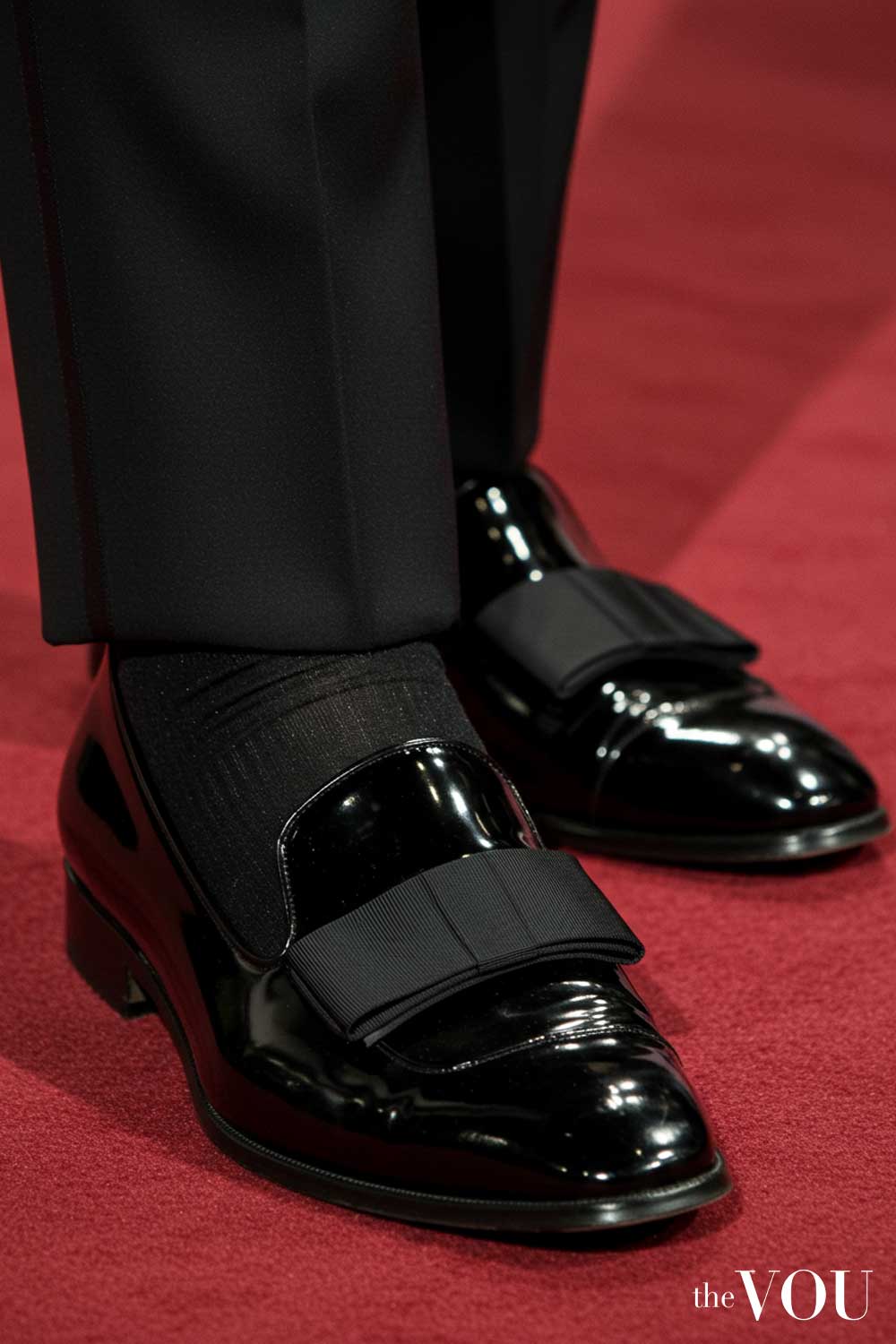
In Continental Europe and the U.S., Derby shoes were also historically worn with white tie ensembles.
While some purists deem the Derby incorrect today, there is historical precedent for its use, and it may be a better option if you have larger feet or a high instep.
Silk hose (socks) are preferable to other types of dress socks due to their aristocratic pedigree and elegant sheen.
Note that Albert slippers or pumps with a higher vamp (covering more of the foot) are never appropriate for white tie.
Origins of Formal Pumps
Formal pumps and silk hose descend from the thin shoes and silk stockings worn with breeches as part of court dress at the royal courts of Europe.
The British still refer to them as “court shoes”, although this term also now refers to women’s low-heeled shoes, just as “pump” refers to a similar style for women in North America.
White Tie Accessories and Jewellery
The main rule for full-dress accessories is that it should be expensive yet discreet.
As Vogue’s Book of Etiquette stated in 1925 about men’s evening jewellery, “Whatever they wear must look as if it were useful by intention and valuable by chance.”
Discreet Cufflinks and Shirt Studs
Most contemporary authorities suggest that shirt studs, cufflinks, and waistcoat studs (if applicable) should be a matching set of mother-of-pearl.
However, there is also a long history of dapper alternatives.
Shirt studs have traditionally been most popular in mother-of-pearl or genuine pearls, but precious or semi-precious stones were also acceptable.
If they matched waistcoat studs, they were often of white pearl, white enamel, or crystal.
Cufflinks could also match the studs or stand apart in plain platinum or plain gold (often white gold).
Onyx, abalone, or dark mother-of-pearl dress sets are better suited to black tie outfits rather than white tie.
Many vintage shirt stud sets are beautiful, but they are often too small for modern white tie shirts and can pop open.
Modern-day shirt studs with a secure mechanism are made to stay in place throughout the evening.
Waistcoat Studs for an Extra Touch of Formality
When white-tie affairs were more common, evening jewellery was a significant market.
Besides adding variety to one’s outfit, removable waistcoat studs had the practical benefit of being taken off for laundering the waistcoat, thus saving them from wear and tear experienced by attached covered buttons.
White Silk Suspenders (Braces) and Optional Sock Garters
Classic white-tie suspenders (braces in the UK) are constructed of white silk.
Sock garters (sock suspenders in the UK) can be of matching material if desired, but this is hardly necessary as both items are classified as underwear and are not intended to be seen.
A Pocket Watch is the Correct Timepiece for White Tie; Avoid Wristwatches
A pocket watch is the most classic and correct timepiece for a full-dress white tie ensemble.
Wristwatches are considered incorrect with white tie.
Traditionally, a pocket watch was worn with a watch fob in the waistcoat pocket, with the fob dangling elegantly from underneath the tailcoat.
A more modern approach, though still classic, is to wear the pocket watch in your breast pocket with a watch chain attached to a lapel pin worn through the buttonhole.
Historical Use of Key Chains
In older photographs and illustrations, you might sometimes see a chain in a gentleman’s pocket that resembles a watch chain but was, in fact, a key chain.
White Linen Pocket Square with Hand-Rolled Edges
A handkerchief of fine white linen with hand-rolled edges is the conventional pocket square for evening wear.
You can also have one with your embroidered initial to make it more personal.
White Boutonnière; Traditionally a Carnation or Gardenia
If a boutonnière is worn with a full-dress white tie, the traditional option is white.
Carnations are the most popular choice, but small gardenias are also acceptable.
In the 1930s, it became acceptable to wear non-white boutonnieres such as red, purple, pink, or yellow carnations.
To make colourful buttonhole flowers work with white tie, ensure the rest of your outfit is strictly black, midnight blue, and white.
The Role of Full-Dress Gloves for Specific Occasions
Indoor dress gloves were once an essential part of a gentleman’s evening dress.
By the 1920s, they were obligatory only at balls, the opera, and when ushering at a formal wedding.
By the 1930s, even these traditions were declining.
Today, they are very seldom needed outside formal banquets, in royal circles, or at some white-tie charity balls.
In America, debutante balls also sometimes maintain the custom of wearing gloves in receiving lines or on the dance floor.
The correct gloves for these occasions are made of white kidskin or lamb nappa leather, in a slip-on or button style.
Cotton gloves, while much less expensive, cannot compare to the luxurious texture and fit of kidskin.
You must remove your gloves when refreshments are served, at which point you may discreetly slip them into the inside tail pocket of your tailcoat.
Outdoor Evening Glove Traditions
Historically, white buckskin gloves were the most popular for outdoor wear in the evening, but white chamois and doeskin (soft suede leathers from sheep or deer skin) were also correct.
A Walking Stick or Cane is Primarily for Historical Costume Events
If you are invited to an Edwardian costume party and aim for historical accuracy, your walking stick (or cane in the UK) should be of plain malacca or other plain wood.
It should have no ornamentation other than possibly a plain silver or gold band to hide the handle joint.
Ornate gold or ivory knobs were considered the mark of an “imitation gentleman” by etiquette authorities like Emily Post in the early 20th century, who also noted that black sticks were “taboo”.
White Silk Evening Scarf with Tasselled Ends
The correct evening scarf for white tie is made of white silk and has tasselled ends.
It should be tied in a classic knot.
Inverness Coat or Peaked-Lapel Overcoat for Outerwear
The Inverness coat, a type of sleeveless overcoat with a cape, is the conventional topcoat for White Tie evening wear.
However, peaked-lapel, silk-faced overcoats are just as acceptable.
Capes with white lining are a very bold statement.
Otherwise, all classic Black Tie overcoats also work for white tie.
A Silk Top Hat is the Traditional Headwear for White Tie
The traditional top hat’s extended height provides a stylish counterbalance to the tailcoat’s length.
Its luxurious finish is the ideal complement to the coat’s silk trim.
It remains a perfectly correct choice if you have the nonchalance to wear it well and are willing to invest in an accessory that will likely be checked at the door.
There are two models of top hat: standard and collapsible.
The best standard models are made from black silk plush or beaver fur felt, which is highly polished to resemble silk.
The silk plush version, commonly known as a silk hat, was the most popular but is no longer made as the last mill producing the required silk has closed.
Such hats must now usually be purchased secondhand from vintage dealers, sometimes at high prices.
Beaver fur felt varieties are still manufactured by some English companies, like Lock & Co. Hatters.
Cheap wool felt top hats are also available, but this material is generally considered suitable only for daytime headwear.
The collapsible model is known as an opera hat, chapeau claque, or gibus.
This model has been acceptable with evening wear since the Regency era and is still made by a few companies.
It has traditionally been constructed of ribbed silk (especially in the US) or dull merino cloth (especially in the UK).
Since the 1960s, some authorities have endorsed a black stiff-brimmed Homburg fedora as a more modern alternative full-dress hat, but its lower crown and dull finish lack the stature of the topper and is generally not recommended for true white tie.
Ensure Correct Top Hat Sizing Using a Conformateur
Although top hats come in the same nominal sizes as regular hats, it is highly recommended that you determine your proper size using a conformateur head measuring device, especially for antique or high-quality new hats.
This is because, unlike felt hats that can mould to your head shape to some extent, a rigid top hat does not adjust.
People have different head shapes (e.g., long oval, oval, more round) even within the same hat size.
The conformateur device determines your precise head shape, allowing a hatter to find or adjust a top hat correctly for your head, preventing discomfort or an improper fit.
White Tie Dress Code Dos and Don’ts
Many conventions and rules are associated with White Tie attire.
Making a mistake with even one element can be glaringly obvious.
Adherence to these guidelines is key to achieving the correct look.
White Tie: What You Must Do
You Must Wear a Quality-Made White Bow Tie Sized to Your Neck
Your white bow tie is a hallmark of the dress code, so ensure it is of the finest quality.
It should be made of the best materials; cotton piqué is the most common contemporary fabric, but white silk can also be used.
The bow tie must be sized to your neck to avoid clunky straps and adjusters, which spoil the clean lines of the White Tie ensemble.
Ideally, the proportions of the bow tie’s bows should also complement the dimensions of your face to prevent your head from appearing out of proportion.
Consider wearing a single-ended bow tie for an especially neat and trim appearance.
You Must Wear a Correctly Cut Evening Waistcoat
Your formal evening waistcoat is a focal point of the outfit.
Ensure your waistcoat is cut sufficiently deep to display your shirtfront adequately.
Crucially, it must not be so long that it peeks out from under the cutaway fronts of your tailcoat.
You Must Wear Formal Evening Outerwear When Appropriate
When travelling to and from a White Tie event, especially in cold weather, proper outerwear will keep you warm and protect your clothes without diminishing the elegant formality of the occasion.
An evening overcoat or a formal evening cape with a contrast lining can create a spectacular effect.
You Must Show an Appropriate Amount of Shirt Cuff
The interplay between the white dress shirt and the black tailcoat is a striking feature of White Tie.
Emphasise this by ensuring that some of your shirt cuff is visible beyond your jacket sleeve.
Traditionally, one-quarter to one-half of an inch is exposed, but slightly more can be shown to balance the higher collar of a formal evening shirt.
You May Wear a Pocket Watch for a Traditional Timepiece
While timepieces were traditionally not worn with White Tie, it has become acceptable to wear a pocket watch since World War I.
A fine chain glittering across your waistcoat can add a unique touch and unexpected visual interest.
For further refinement, consider affixing your pocket watch with a chatelaine, an elegant fabric fob that drapes from your waistcoat.
You Can Express Individuality Through White Tie Accessories
When so much of a White Tie ensemble is fixed by rules, you can express yourself creatively in the few remaining avenues.
A vibrant, yet tasteful, real boutonnière is an easy way to add unexpected colour; classic varieties include red or white carnations or roses.
Fine studs create lustrous visual interest at your midsection, as do elegant cufflinks at your wrists.
A silk top hat or formal evening gloves, once standard, will now make you stand out as a man of rare taste.
You Must Wear Black Patent Leather Shoes or Highly Polished Oxfords
While opera pumps were traditionally the only shoes worn with White Tie, it is now acceptable to wear either whole-cut or plain capless Oxfords in black.
Derbies are also historically acceptable in some regions of Europe.
Patent leather versions of these shoes will look especially appropriate due to their bright, shiny appearance, which emphasises the formal nature of the occasion.
You Must Wear Over-The-Calf Black Silk Evening Socks
White Tie requires refined elegance from head to toe.
Avoid socks that puddle around your ankles.
You must wear over-the-calf socks, which stay in place because they sit at a natural flexion point of the leg.
Furthermore, these socks should be in sheer black silk to match the formality of the occasion; cotton and wool socks are associated with daywear.
You Must Wear Your White Tie Ensemble with Confidence
No matter how correctly you wear your White Tie ensemble, it will never look right unless you wear it with confidence.
Adhering to the advice in this guide will ensure that every aspect of your ensemble is correct.
Therefore, you can wear it with total pride, confident that you look as elegant and dapper as possible.
White Tie: What You Must Not Do
You Must Not Wear Slippers Instead of Formal Pumps or Shoes
White Tie traditionally calls for opera pump shoes, also called court shoes.
While opera pumps resemble slippers because they are both slip-on shoes, they are different.
Opera pumps have a much lower-cut vamp, elegantly displaying your fine silk evening socks.
Slippers, including velvet Albert slippers, have a higher vamp and can feature decorative elements incongruous with White Tie formality.
You Must Not Wear a Fake or Poor-Quality Boutonnière
If you wear a boutonnière, use a genuine flower or a high-quality artificial one that looks real.
A fake boutonnière that is excessively exuberant or clearly ersatz becomes a distraction that mars the look of your ensemble.
You Must Not Wear a Necktie
Neckties are never intended to be worn with formal evening attire, whether Black Tie or White Tie.
The “white tie” in “White Tie” refers specifically to a white bow tie, not a white necktie.
You Must Not Omit the Bow Tie
A White Tie ensemble absolutely requires a “white tie” (bow tie).
Do not attempt to go without neckwear.
The bow tie is necessary to create a visual bridge from your shirtfront, over the shoulders of the jacket, to your face, drawing the eye upwards.
You Must Not Wear a Day Suit Jacket or Tuxedo Jacket Instead of a Tailcoat
Day suit jackets and tuxedo jackets (dinner jackets) are cut differently from evening tailcoats and are not acceptable substitutes.
Their proportions will be incorrect and spoil the lines of the White Tie ensemble.
A tuxedo jacket is intended for Black Tie only.
You Must Not Wear a Cream or White Dinner Jacket
Off-white, cream, and white dinner jackets are warm-weather alternatives for Black Tie ensembles.
They are not intended to be worn with White Tie, even though they happen to be white.
You Must Not Wear a Morning Coat for an Evening White Tie Event
While a morning coat is a type of tailcoat, it is for formal daytime wear and differs significantly from an evening tailcoat in its cut and appearance.
The morning coat’s oblique cutaway and broader tails make it too substantial and inappropriate for an evening White Tie occasion.
You Must Not Wear Notched Lapels on Your Tailcoat
Notched lapels are a feature of day business suits and some less formal jackets.
While sometimes seen on modern, mass-produced tailcoats, they are inappropriate for the solemnity and decorum of a White Tie occasion.
Formal evening tailcoats must have peaked lapels.
You Must Not Wear a Cummerbund
A cummerbund is a waist covering specifically for Black Tie.
The White Tie dress code requires a white formal evening waistcoat as its waist covering.
A cummerbund is therefore inappropriate and redundant.
You Must Not Wear Spats
Spats are a vintage accessory for formal daytime attire, such as morning wear.
They should not be worn with White Tie.
As White Tie events are typically indoors, spats serve no practical purpose and will appear affected.
You Must Not Wear a Black Shirt
Evening shirts for White Tie must be white.
Black evening shirts, sometimes worn with other dress codes for a monochromatic look, are incorrect for White Tie and would obscure the important details of your ensemble.
You Must Not Display Prominent Designer Names or Logos
Classic style, particularly the refined setting of White Tie, avoids ostentatious branding.
An essential element of formal attire is the elegant uniformity it creates; visible labels or logos are out of place.
You Must Not Wear a Wristwatch
Traditionally, no kind of watch was worn with formal attire.
While dress wristwatches have become common with Black Tie, they remain unacceptable with White Tie ensembles.
The bulk of a wristwatch spoils the tapered effect of the single cuffs and cufflinks.
A pocket watch is the only appropriate timepiece.
You Must Not Wear a Studless Shirt or a Turndown Collar Shirt
A critical feature of the formal evening dress shirt is its ability to take studs, which are decorative and functional.
Plain buttons are not an acceptable substitute for studs on the shirtfront.
Traditional White Tie shirts also feature a detachable wing collar affixed with studs.
While shirts with an attached wing collar are now common, the collar must always be a wing collar, not the turndown style seen with some Black Tie outfits or daywear.
You Must Not Show Hidden Shirt or Waistcoat Tabs
The White Tie ensemble uses various buttons, tabs, and bands to hold everything in place perfectly.
These working features should remain hidden so that the overall appearance is effortlessly elegant.
Ensure any tabs that hold your waistcoat or shirtfront in place are secured correctly to the inside of your trousers and remain hidden from view.
You Must Not Wear an Overly Long Waistcoat
White Tie ensembles require an exceptionally cut evening waistcoat that is considerably shorter than a day waistcoat.
Even formal evening waistcoats can sometimes be too long relative to the tailcoat, often due to the lower rise of modern trousers.
This results in the white waistcoat peeking out below the black cutaway fronts of the tailcoat, which is a significant error.
Achieving the correct waistcoat length relative to your tailcoat and trousers is crucial and may require bespoke tailoring.
White Tie Attire Shopping Tips
When acquiring attire for society’s most exclusive occasions, you should not compromise on quality.
If your social calendar merits owning a full-dress white tie kit, judge each potential purchase by its ability to enhance the evening’s distinction rather than by its price.
The ideal tailcoat and trousers would be custom-tailored for you.
Choose a Bespoke White Tie Outfit for the Perfect Fit
There is no better way to ensure the perfect fit and regal air of a full-dress suit than having it made bespoke.
Prices for bespoke white tie can vary significantly, from several thousand pounds upwards.
Qualified full-dress tailors are rare.
If you choose the custom route, select a tailor experienced in cutting these specific body coat garments to avoid issues with proportions or the fit of the tails.
Tailors in established centres of bespoke tailoring, such as London’s Savile Row, or those with a tradition in formalwear in cities like Vienna or Paris, are often good choices.
Consider Ready-To-Wear Tailcoats from Reputable Brands with Expert Alterations
A less ideal but more pragmatic approach is to purchase a ready-to-wear ensemble.
Take time to find a make that suits your body type, then employ a skilled tailor to alter the garments for the best possible fit.
When shopping, look for superior designer brands and upscale sellers specialising in formalwear.
Avoid formalwear retailers that categorise tailcoats merely as a type of tuxedo or offer them primarily for costume hire.
Explore Vintage Tailcoats for Old-World Craftsmanship
You should aim to purchase your own white tie garments rather than hiring, especially for the core elements.
If you must hire for a once-in-a-lifetime event, it is still wise to purchase key accessories like the correct shirt, collar, bow tie, and waistcoat to ensure they are correct and fit well, as hire stock can be limited or of lower quality.
A well-preserved vintage tailcoat can offer excellent value, providing unmatched old-world tailoring, details, and style features, often for less than a new, lower-quality suit.
However, finding one in your size that is in good condition can be challenging.
As with new tailcoats, seek out quality brands and reputable specialist retailers when shopping for white-tie accompaniments.
Sources for Full-Dress Shirts & Collars
Darcy Clothing (formerly The Vintage Shirt Company) is a specialist offering authentic collarless shirts and detachable collars.
Ede and Ravenscroft are specialists offering collarless shirts and detachable collars.
Toastmaster Clothing, also known as Court Case or LegalWear.co.uk, is a legal wear and eveningwear retailer offering Frederick Theak collarless marcella shirts.
Luke Eyres is a manufacturer and wholesaler of detachable collars that supplies many UK retailers (they may have minimum order quantities).
Brooks Brothers sometimes offers a full-dress detachable collar shirt (complete with collar).
Sources for Full-Dress Waistcoats
Oliver Brown is an upscale retailer offering premium evening wear.
Ede and Ravenscroft is a retailer offering premium evening wear.
Toastmaster Clothing (Court Case/LegalWear.co.uk) offers Frederick Theak marcella waistcoats.
Clermont Direct is an online formalwear retailer that sometimes offers sized waistcoats complete with waistcoat studs at a lower price point.
Sources for White Tie Accessories
Various manufacturers and retailers carry White Tie accessories, but be wary of subpar products intended to take advantage of the limited market availability.
See below for a curated selection of suggested stores for White Tie attire:
Fort Belvedere is a one-stop shop with a quality selection of white tie accessories, including pocket squares, gloves, evening scarves, boutonnieres, silk socks, and bow ties.
Lock & Co. Hatters is a mail-order shop for new and restored vintage top hats.
Oliver Brown Top Hats is a London shop for new and restored vintage top hats.
Charles Gale Clothing is a retailer of Christy top hats.
Darcy Clothing (formerly The Vintage Shirt Company) offers various period-appropriate items.
Clermont Direct sometimes offers waistcoat studs.
Toastmaster Clothing (Court Case/LegalWear.co.uk) offers shirt collar studs and waistcoat studs.
Ede and Ravenscroft, a legal wear specialist, offers sterling silver shirt collar studs and leather storage boxes for detachable collars.
Farthingales is a supplier of gold/brass collar studs, often used for historical reproductions.
White Tie Frequently Asked Questions (FAQs)
Is White Tie different from Black Tie?
Yes, White Tie is different from Black Tie.
Both are formal evening dress codes, but the White Tie dress code is significantly more formal and has stricter rules.
Black Tie requires a dinner jacket ensemble (tuxedo), while White Tie demands an evening tailcoat ensemble.
Black Tie is worn with a black bow tie, and White Tie is worn with a white bow tie.
Is a morning tailcoat the same thing as an evening tailcoat?
No, a morning tailcoat is not the same as an evening tailcoat.
A morning tailcoat, for formal daywear, is typically grey or black, has a gradually sloping cutaway front, and its tails are shaped differently from an evening tailcoat.
An evening tailcoat has a sharp, horizontal cutaway front and longer, more slender tails, often described as a “swallow-tail”.
It is traditionally made from black or midnight blue fabric.
Does “formal attire” mean the same thing as White Tie?
The term “formal attire” can be ambiguous.
Historically, “formal evening attire” always meant White Tie, and “formal day attire” always meant morning dress.
Nowadays, Black Tie is also considered “formal attire” for evening events, though it is less formal than White Tie.
In very casual contexts, some people might use “formal attire” to mean simply “dressing up” in a regular suit, so it’s important to understand the context or specific dress code mentioned on an invitation.
What distinguishes a day waistcoat from a formal evening waistcoat for White Tie?
A day waistcoat typically covers most of the midsection, has a relatively high buttoning point, and has a full back.
A formal evening waistcoat for White Tie has a much lower V or U-shaped opening, exposing considerably more of the shirt front.
Its hem is also cut somewhat higher to align with the tailcoat fronts, and it is usually backless to aid air circulation and reduce bulk under the close-fitting tailcoat.
What makes a shirt a formal evening shirt for White Tie?
A formal evening shirt for White Tie must be white, typically made from cotton or linen in a broadcloth or voile weave.
It is designed to take a detachable wing collar, which is heavily starched.
It has a stiff bib front, usually made of marcella piqué, also heavily starched.
The cuffs are single-layered, starched, and fastened with cufflinks (not buttons).
The shirt front is closed with decorative studs instead of buttons.
What does “full fig” mean in relation to White Tie?
“Full fig” is an idiomatic expression indicating that one is fully and correctly dressed in a smart and proper manner for a particular occasion.
It is likely a truncation of the expression “to be dressed in full figure.”
The term “full fig,” along with “full dress,” is sometimes used to refer to dressing in White Tie, as this dress code represents the epitome, or “full figure,” of formal attire.
When is the White Tie dress code typically employed today?
The White Tie dress code is extremely rare in the modern world.
It is most often associated with events of the highest pomp and dignity.
These include royal occasions such as coronations or some state banquets, certain very traditional cultural events like the Vienna Opera Ball, or highly exclusive social gatherings and stately dinners, such as some aristocratic weddings or state receptions for heads of state.
Some very formal gala events, like the Metropolitan Museum of Art’s annual Met Gala (though interpretations there can vary widely) or the Alfred E. Smith Memorial Foundation Annual Dinner, may also specify a White Tie dress code.
With years of expertise in high-end fashion collabs and a PhD in Sustainable Fashion, Ru specialises in eco-luxe wardrobes for the modern gentleman seeking understated refinement.
A passionate advocate for inclusivity and diversity, Aidan is the driving force behind The VOU as its Editorial Manager. With a unique blend of editorial acumen and project management prowess, Aidan's insightful articles have graced the pages of The Verge, WWD, Forbes, and WTVOX, reflecting his deep interest in the dynamic intersection of styling with grooming for men and beyond.
After years of managing hundreds of fashion brands from London's office of a global retailer, Mandy has ventured into freelancing. Connected with several fashion retailers and media platforms in the US, Australia, and the UK, Mandy uses her expertise to consult for emerging fashion brands create top-notch content as an editorial strategist for several online publications.
With over twenty years of front-row fashion and styling events, collabs with haute-couture houses, and a PhD in Luxury Fashion, Laurenti is an expert in crafting personalised looks that depict old-money sophistication.


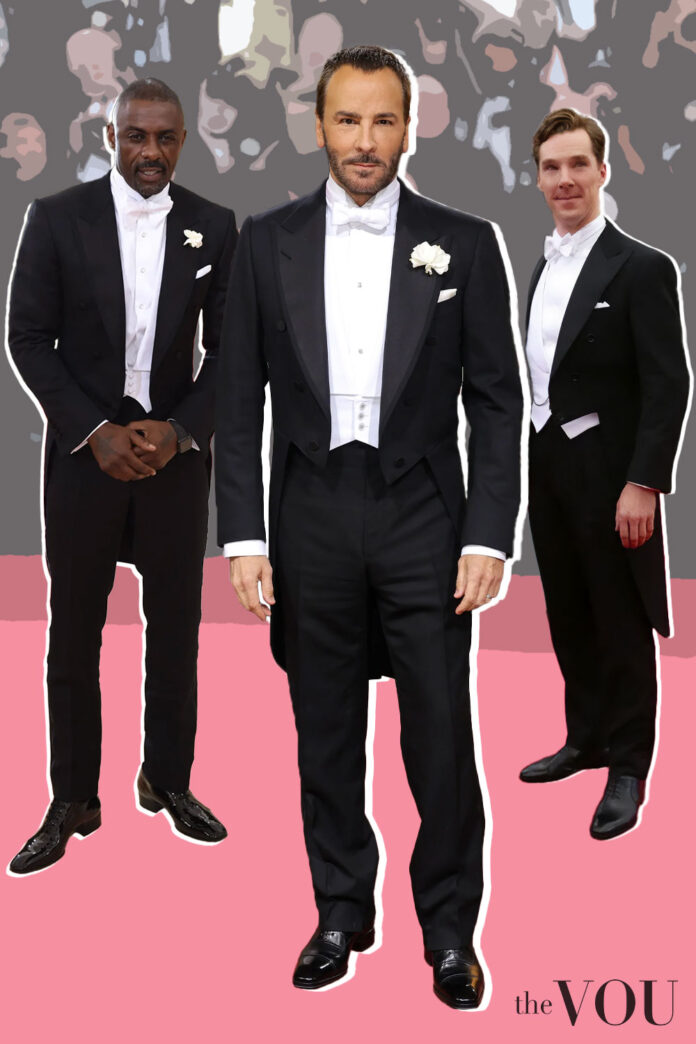
Interesting to see how strict the white tie code remains even today. I’d love to see more tips on how men can add subtle personal style touches without straying from tradition.